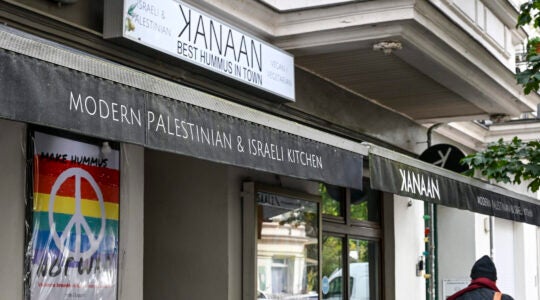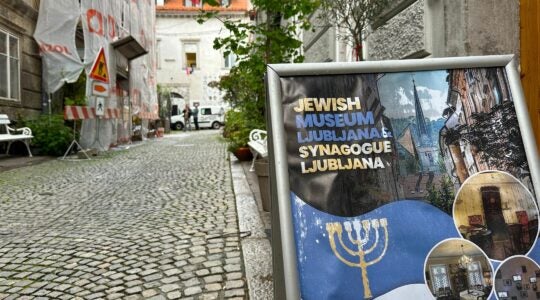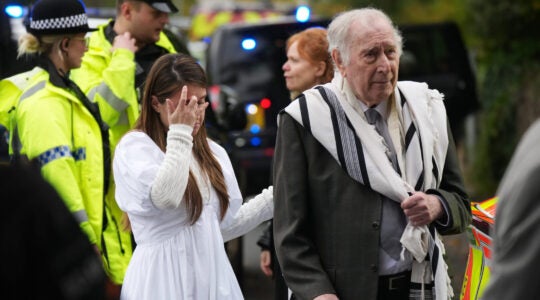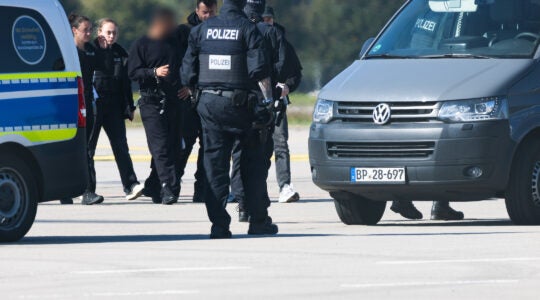MALAKHOVKA, Russia (JTA) — In Soviet times, the small town of Malakhovka, less than 10 miles from Moscow, was the center of Jewish underground activity. In 2005 its old wooden synagogue was burned down in a fire — for the second time.
Five years later, the shared effort of local authorities and wealthy Moscow Jews have enabled the building of a new synagogue.
“There’s a silver lining to the cloud,” one of Russia’s chief rabbis, Berel Lazar, said at the recent opening ceremony, referring to the ’05 blaze. “Malakhovka Jews have always been God fearing, and He wanted them to have a decent building to organize Jewish life. Now we can see this happen.”
The synagogue was built with the financial backing of Moscow businessman Alexander Kaplan, who said he felt a break in tradition upon learning that the old synagogue had been burned down and wanted to bring it back. Kaplan had grown up in Moscow, but his relatives lived in Malakhovka, and as a child he spent summers with them.
Local authorities had allowed the Jews to pray in the former administration building — they did not miss a single Shabbat service, one of the community leaders, Mikhail Glimcher, told JTA. The officials also endorsed a plot of land to build a new synagogue without delay.
“They understand it’s better to be friends with us because elections happen,” said Glimcher, the former community head who is seen as the main force behind the new construction.
Representatives of the local authorities were on hand for the opening ceremony. The head of administration of Malakhovka, Alexander Avtaev, presented the community with a big gilded key and Lazar with a bunch of white roses.
All the citizens of Malakhovka “were upset to know that the synagogue had been burned, and looked forward to the opening of a new one,” Avtaev said.
The building also will house a community center, a mikvah, dining hall, and chess and women’s clubs for a Jewish community of approximately 400.
The synagogue sits in a Moscow suburb known for two reasons: Malakhovka has played host to the summerhouses of many famous artists, and historically it has been populated by Jews.
Old-time residents recall that some 50 years ago, one could hear Yiddish spoken in local shops. In a town of about 18,000, some streets were populated entirely by Jews.
it isn’t clear why Malakhovka became such an attraction for Jews, but it’s likely that Jews had begun to settle here, inside the Pale of Settlement, even before the 1917 revolution. Some speculate that local authorities were loyal to Jews.
Today’s Malakhovka residents prefer to think that the Jews chose Malakhovka simply because of its beauty. Surrounded by pine groves, the town wins high marks in real estate ratings. Also, trains make it easy to reach the center of Moscow.
Another popular conjecture is that Jews liked the place because of a big market held here on weekends.
“When a morning train would come on Sunday, local anti-Semites would go to the platform shouting ‘Berdichev has come!’ ” recalls Eugenia Umanova, 79, who has spent her whole life in Malakhovka and worked as a doctor at a local clinic. Berdichev is a small town in Ukraine inhabited mainly by Jews.
From 1919 to 1922, Marc Chagall taught here in a Jewish orphan colony. In the late 1920s, the sixth Lubavitcher rebbe spent three weeks in Malakhovka, living in the house of a Lutheran woman who let Jews pray at her place.
In 1932, a synagogue was built near the house of a local Jewish activist, Noah Alterman. To circumvent Soviet-era restrictions on religious organizing, the building was registered as a “shed for household equipment.” Five years later the owner of the house was arrested and subsequently executed for “anti-Soviet activity.”
The synagogue became state property, and Malakhovka Jews continued to pray secretly.
“My father was a baker,” said Serafima Gorinova, an elderly participant in the synagogue’s opening ceremony. “There are several dozens Jews around us, and allegedly no KGB officers — though you never know, of course.”
Gorinova lowers her voice instinctively and leans down to whisper in a reporter’s ear: “Half of Moscow Jews came here to buy his matzahs.”
In 1959 the synagogue was set ablaze for the first time. The Jewish community reconstructed the building in the 1970s, and in 2005 it became the community’s property. But just two months later the building was burned down again: A drug addict broke in looking for valuables and then set the house on fire to cover his tracks.
At the opening ceremony for the new synagogue, community head Aaron Kogan said, “I hope we’ll see as many people here each Shabbat as we see now.”
That’s unlikely: Shabbat services in the old synagogue typically attracted 20 to 30 worshipers, with the average age of participants being well over 60.
Asked whether he attends services at the synagogue, Glimcher said, “I was once awarded the best school director prize for organizing atheistic propaganda at school. But I will go there. Life is full of wonders.”
JTA has documented Jewish history in real-time for over a century. Keep our journalism strong by joining us in supporting independent, award-winning reporting.





